TechRadar Verdict
The Samsung Galaxy Note 20 Ultra checks off a lot of bests for new phones in 2020, including the best camera on an Android phone and the best-looking display on any phone, period. This is the only stylus-included handset we recommend, and while the competition is thin, it’s not undeserved – you’re just going to have to pay a heap of money for this powerful ‘everything phone’.
Pros
- +
5x camera zoom crushes it
- +
New useful S Pen features
- +
The best screen on a phone
Cons
- -
‘Ultra’ expensive
- -
Slower charging
- -
Photos still exhibit smoothing
Why you can trust TechRadar
Update: Our Samsung Galaxy Note 20 Ultra review has been refreshed to include updated information about the price and reliability, and to highlight newer alternatives, such as the Samsung Galaxy S21 Ultra.
Two-minute review
The new Galaxy Note 20 Ultra has a camera that’s ready to take your extreme close-up – and a lot of your money. Samsung’s business-class phone has certainly become an investment, to the point where you may ask yourself “Do I really need an ‘everything phone’?”
It’s the best 2020 camera phone on the Android platform thanks to its 5x optical zoom, 50x digital zoom, fun portrait filters and easy-to-use camera app interface. Samsung's S Pen stylus once again enables you to remotely snap photos, and the 960fps super slow-mo videos we took amaze friends even if it’s a Galaxy S9 Plus era feature.
We’ve had more fun testing the Note 20 Ultra than any other smartphone in 2020. The past two weeks have been spent zooming in on New York’s iconic landmarks without the usual quality loss. How closely can we zoom in on the Statue of Liberty from the tip of Manhattan? The results will surprise you.
This fun factor helps compensate for the fact that this camera isn’t always pixel-perfect in stringent side-by-side comparisons with the iPhone 12 Pro Max and Google Pixel 5. Samsung’s photo processing still aggressively smooths textures in low-light conditions if you look closely enough, although its Night Mode has gotten better.
Our core issues with the Samsung Galaxy S20 Ultra have been addressed with the Note 20 Ultra. The camera adds a laser autofocus – without it on the S20 Ultra, out-of-focus photos became so much of an issue, we began recommending to people the S20 Plus due to its lower resolution camera but more stable Dual Pixel Autofocus. The new Note design also looks and feels more premium than the S20 Ultra. The Mystic Bronze color of our review unit certainly helped.
Of course, there's now the newer Samsung Galaxy S21 range - including the Samsung Galaxy S21 Ultra, which zooms further than the Note 20 Ultra, and even supports the S Pen stylus.
Sign up for breaking news, reviews, opinion, top tech deals, and more.
Still, the Note 20 Ultra is the complete package from Samsung: it has a 6.9-inch 120Hz display that moves fluidly under the finger, a fast new chipset, 12GB of RAM (more than some of the best laptops), 5G speeds, and all-day battery life. The S Pen also comes with brilliant new features, like syncing voice recordings with your scribbled-down notes (students and journalists in lectures will love that). Power users will have no complaints.
The regular Note 20 has some of these features, but falls short in terms of both specs and design of what you’d expect from a Note phone in 2020 – there’s no microSD card slot, the camera maxes out at 3x zoom, and the back glass isn’t actually glass. If you're going to drop over a grand on a new smartphone, you might as well spend a couple of hundred more dollars or pounds and get the very best.
There are things the Note 20 Ultra can’t do, but most of them don’t matter. Although the phone supports a QHD resolution, Samsung defaults it to 1080p – it still can’t do the 120Hz refresh rate and QHD at the same time, while the OnePlus 8 Pro and newer Galaxy S21 Ultra can.
Because 60Hz is harder to live with when we’re getting used to higher refresh rates, we kept the resolution at 1080p. It looked perfectly fine. We didn’t miss the extra pixels, and we don’t think most people will notice the difference on a screen of this size.
We also didn’t miss the 100x ‘Space Zoom’ gimmick from the S20 Ultra, which Samsung has dropped here. It was a neat party trick, but anything beyond a 50x zoom was often unusable depending on the lighting conditions. Also dialed back: the marginally better S20 Ultra 40MP selfies (offering finer detail when cropping in on photos). They’re 10MP on the Note 20 Ultra, but the file sizes and the front camera punch hole are both smaller. Trade-offs.
Samsung wants you to think that the Note 20 Ultra has it all, and it kind of does if you’re okay with its lack of truly fast 45W charging and the lack of a standard 3.5mm headphone jack. Without Android complete with Google services on the Huawei P40 Pro, Samsung stands alone when it comes to pushing Android camera phones to the next level while still ensuring that you can easily check your Gmail; although of course, the iPhone 12 range makes for a strong iOS alternative.
Going back to the question we posed at the start of this review: do you really need Samsung’s ‘everything phone’? If you don’t need it all – the S Pen, the 5x optical zoom, and the souped-up chipset – then the more conservatively priced Galaxy S20 Plus does 3x zoom sans a stylus. But if you do need it all, and money is no object, then do buy the Note 20 Ultra – or the similarly high-end Samsung Galaxy S21 Ultra.
Either way, Samsung will lend you an S Pen to sign it all away.
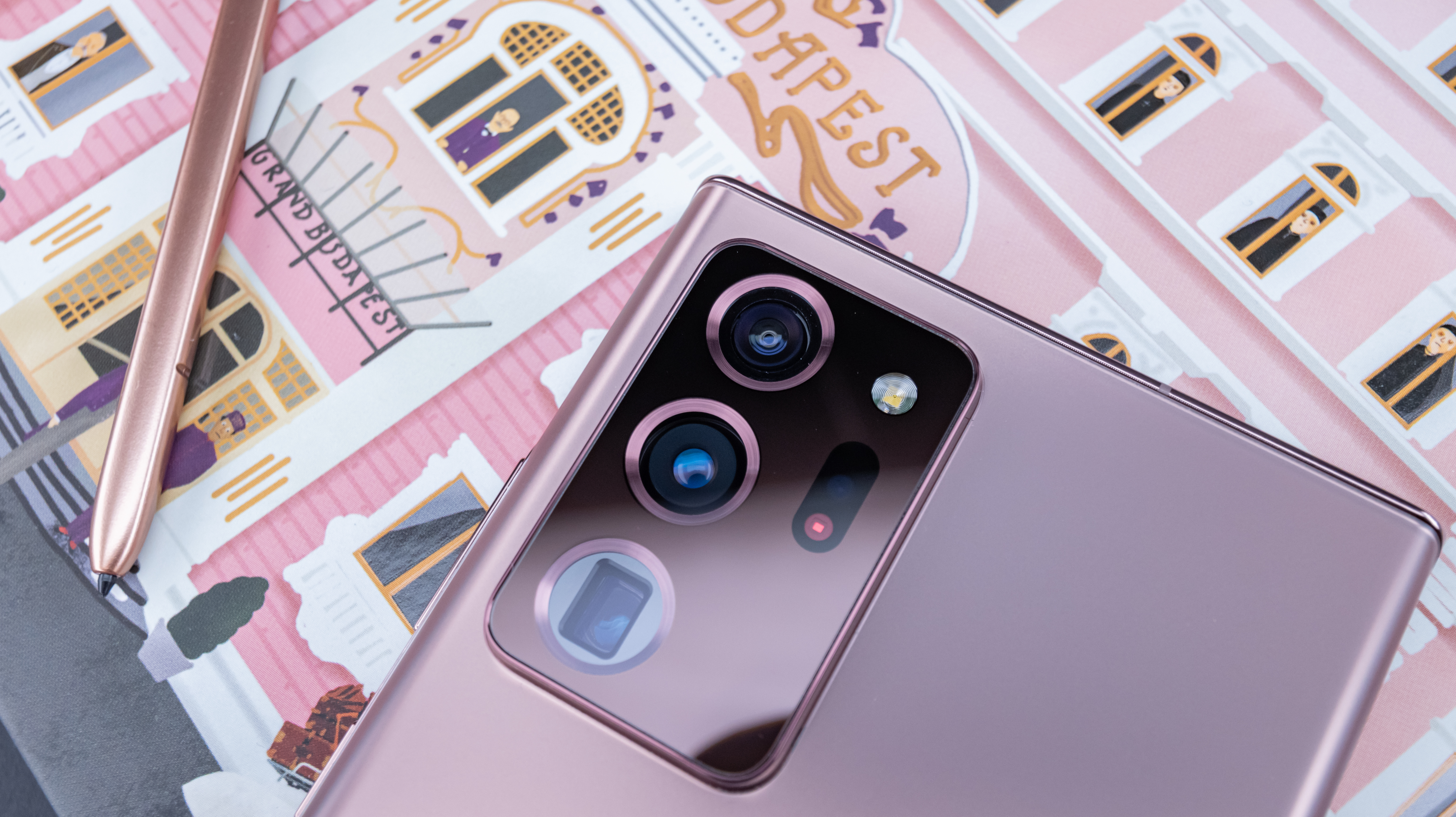
Galaxy Note 20 Ultra release date and price
- Note 20 Ultra released worldwide on Friday, August 21, 2020
- $1,299 / £1,179 / AU$1,849 for base model (128GB US, 256GB elsewhere)
- $1,449 / £1,279 / AU$2,199 for version with 512GB of storage
Weight: 208g
Dimensions: 164.8 x 77.2 x 8.1mm
Display size: 6.9-inch
Resolution: WQHD+
Refresh rate: 120Hz
Pixel density: 496ppi
Software: Android 11, OneUI 3.0
Chip: Snapdragon 865 Plus / Exynos 990
RAM: 12GB
Storage: 128GB (US) / 256GB (UK, AU) / 512GB (global)
Rear cameras: 108MP/12MP + 12MP + 12MP
Front camera: 10MP
Battery: 4,500mAh
Rating: IP68
The Galaxy Note 20 Ultra release date was Friday, August 21 following a round of pre-orders that started after the August 5 announcement. You can still find some Galaxy Note 20 Ultra deals, even if some of the pre-order bonuses have dried up.
The ‘cheapest’ Galaxy Note 20 Ultra costs $1,299 / £1,179 / AU$1,849. In the US, that gets you a 128GB of internal storage, rather meager for power users, while in the UK and Australia, the base model has a more proper 256GB.
Broken up into monthly payments, that's $54.16 in the US on a 24 month contract for the 128GB version. All versions have 12GB of RAM and a microSD card slot for expanding on the built-in storage.
The top-end Note 20 Ultra has 512GB of internal storage (again with 12GB of RAM), and costs $1,449 / £1,279 / AU$2,199. In Australia, there's also a 4G-only version of the phone that costs AU$1,849, but you can't buy that in the UK or US.
All of these are launch prices - in practice you can often now find it for less if you shop around, but this is still a very expensive phone.
The Note 20 Ultra is also far more expensive than the slightly smaller Note 20, but Samsung really holds back on the specs and design of this year’s normal Note and still charges $999 / £849 for it. You must really want that stylus not to go with the S20 Plus or Galaxy S21 Plus instead of the Note 20.
If meanwhile you want the very best that Samsung has to offer, that's not the Note 20 Ultra anymore, as the Samsung Galaxy S21 Ultra has it marginally beat.
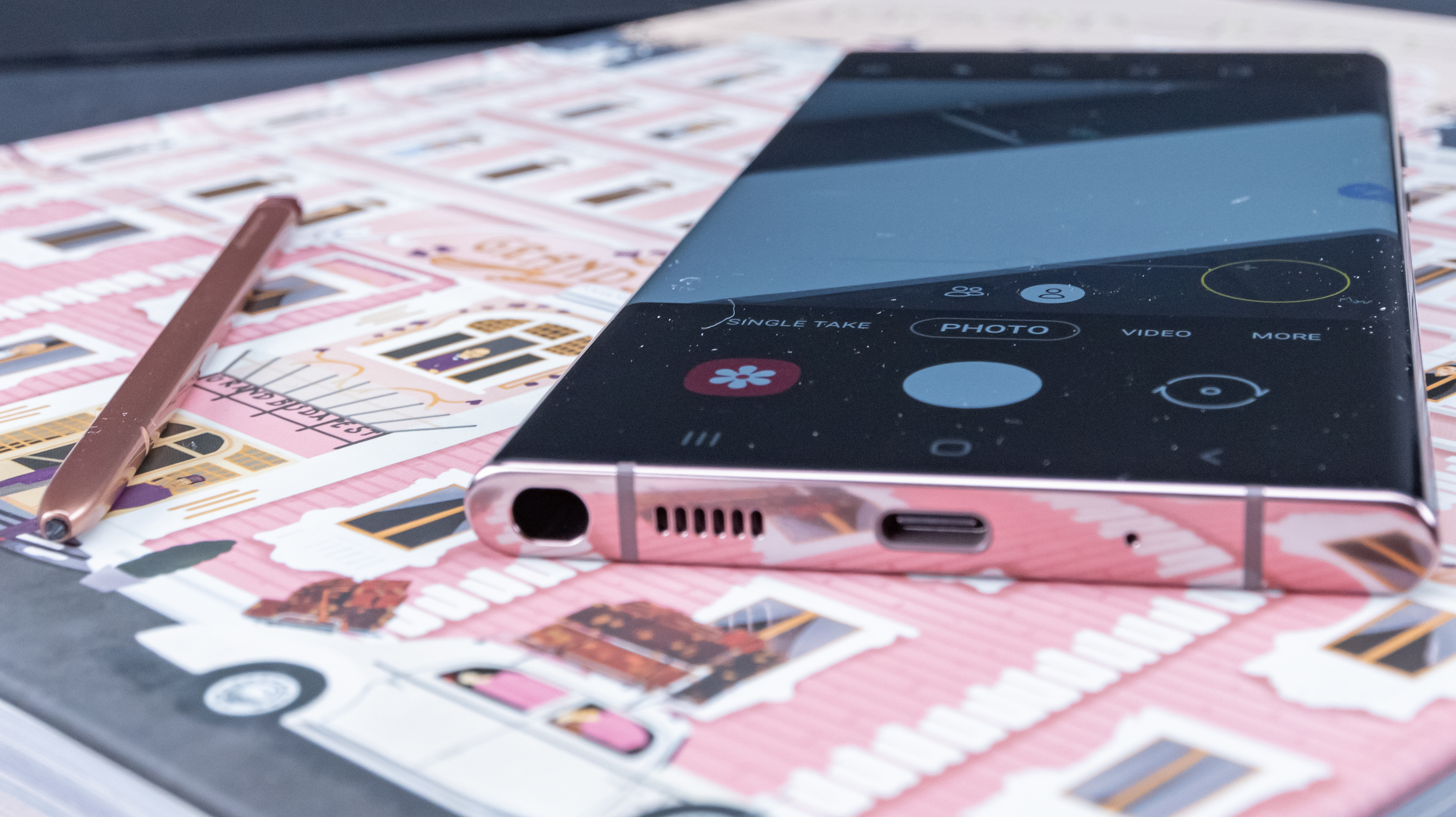
Design
- Really big phone with squared-off corner; takes two hands to use
- Mystic Bronze color overshadows Mystic Black and Mystic White
- In-screen fingerprint sensor carried over from Note 10 Plus
Big doesn’t necessarily define the Note series anymore. Oh, the Note 20 Ultra is a massive phone in the hand, requiring two meaty paws to operate it – it's just no longer uniquely big. It shares the same 6.9-inch screen size with the S20 Ultra.
What’s different is that Samsung found ways to make the Note 20 Ultra design better, not necessarily bigger. It has a polished look with a less reflective glass back that also happens to reduce unsightly smudges.
The copper-toned Mystic Bronze color stands out most of all with this frost-coated glass back, while the less stylish Mystic Black and Mystic White options for those who don’t share our impeccable taste.
Samsung’s latest top-of-the-line Note continues to buck the trend that outfits phones with rounded corners. It stands straight up with a more square frame, which is only softened on the right and left sides by the curved Infinity Display.
Is this squared-off frame better than a rounded one? That’s highly subjective, but it allows for the S Pen to easily slide straight up into the left side of the phone – a minor change from the right-side slot where previous Note phones had you holster the stylus.
There’s a large camera bump on the back of the phone, but the payoff is that the 5x optical zoom works so well. The cleaner photos have been worth it, and to want a smaller bump while also demanding the same zoom levels is to deny physics, or reality (or both).
Some people have launched complaints about dust getting in the Samsung Galaxy Note 20 Ultra camera housing, though we haven't experienced much that in our extensive testing. The complaints appear to be – mostly – limited to Korea.
Most Galaxy Note 20 Ultra cases will level things out so that the camera bump isn't an issue, and given the fact that this is such a large and heavy phone, it’s best to protect your investment with one.
We felt most at risk when thumbing our way to the in-screen fingerprint sensor, which has a limited 9x4mm invisible landing space on the bottom third of the display, same as the Note 10 Plus. The sensor works most of the time, but accessing it with one hand on a phone this big is downright dangerous.
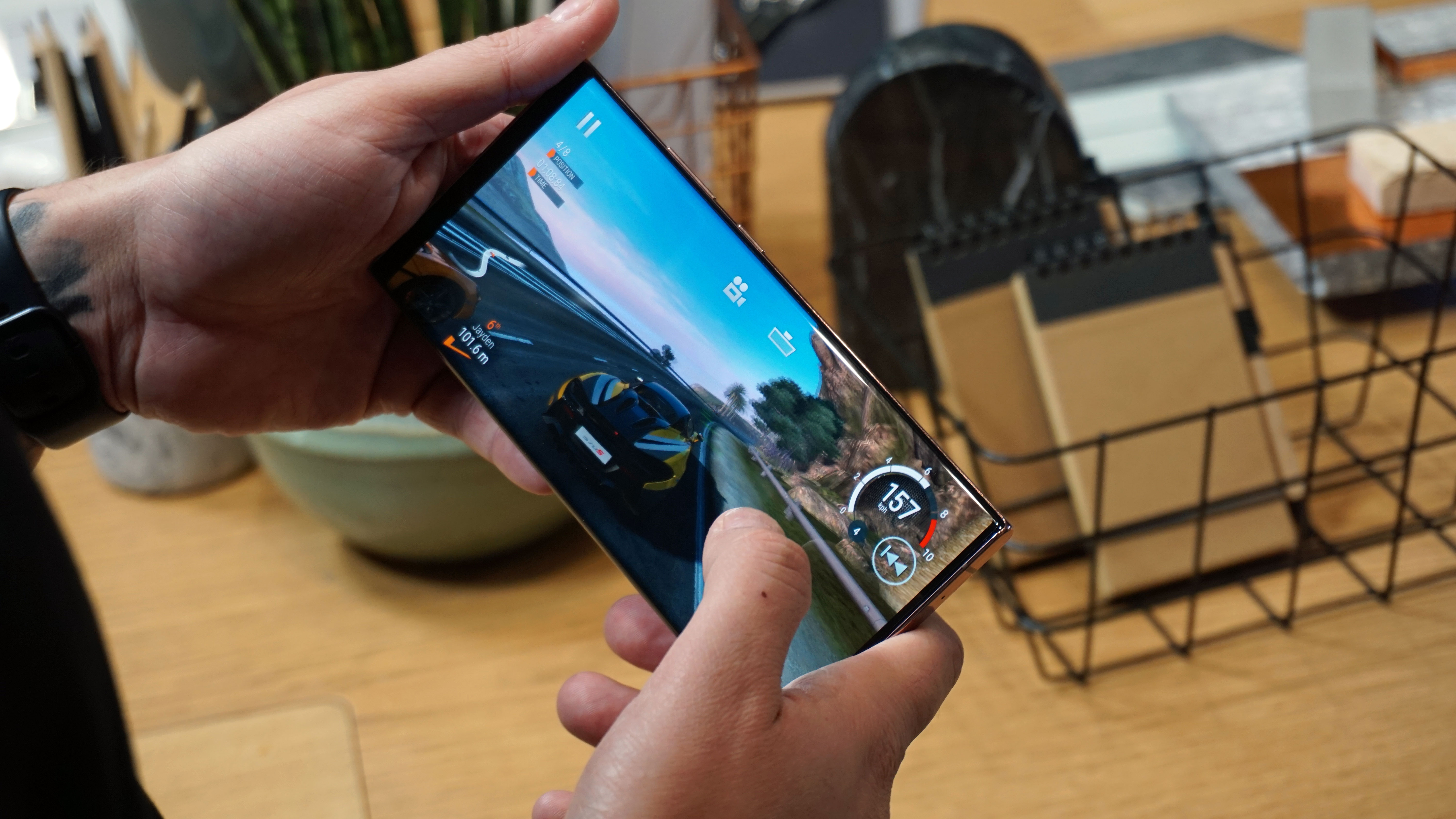
Display
- First Note with a 120Hz screen refresh rate for smoother motion
- Max resolution is WQHD+, but drops to 1080p with 120Hz enabled
- Best-looking curved display with a small front camera punch hole
The Galaxy Note 20 Ultra has the best display on any smartphone – that’s usually the case for new Samsung phones for about six months, until the company unseats itself with newer display tech. Cue the Galaxy S30.
Samsung has already wowed us with a 6.9-inch 120Hz display on the S20 Ultra, but the compromise here is the same as with that phone: you have to choose between 120Hz in 1080p, or dropping to 60Hz to enjoy the QuadHD resolution.
The decision is an easy one: the 120Hz 1080p setting looks good out of the box, and most people we know who are upgrading from the Note 8 have been impressed. The 6.9-inch screen isn’t big enough to see individual pixels, and we won’t truly need higher resolutions until foldable phones become mainstream.
What matters more is the 120Hz fluidity when playing games and watching movies. Action is smoother, and because Samsung uses an adaptive refresh rate the display isn’t always chugging at 120Hz; when you’re reading email, for example, the phone is smart enough to drop the refresh rate back down to lower levels and save battery life.
The regular Note 20 doesn’t have this faster refresh rate – and its maximum resolution is 1080p, so there’s no choice to make. The only advantage some may see in the 6.7-inch screen of the Note 20 is the fact that it’s flat and not curved – another subjective design choice.

Camera
- Amazing telephoto camera with a 5x optical zoom and 50x digital zoom
- Special '108MP' photo mode isn't very useful and just takes up storage
- 960fps super slow-mo videos are fun, but remain at a low 720p resolution
- Samsung has the easiest-to-use feature-packed camera UI
Distance. It used to be a problem for smartphone cameras, which were incapable of making distant subjects look anything other than, well, distant.
The Note 20 Ultra addresses this problem with a camera that zooms into scenes with a 5x optical zoom and maximum 50x digital zoom, and this is where Samsung’s new camera stands out. It makes the iPhone’s 2x optical zoom feel like meaningless image cropping.
(Thread) The Samsung Galaxy Note 20 Ultra camera zoom is... impressive. 0.5x ultrawide / 1x regular / 5x optical / 50x digital 😯Thoughts? pic.twitter.com/jUMeX0yb59August 15, 2020
We found Samsung’s photos to be clear up to 10x zoom, depending on the lighting conditions and how we were viewing the photos (on the phone screen vs a larger computer monitor). No, this telephoto lens doesn’t have that 100x 'Space Zoom' feature, as seen in our S20 Ultra camera test, but that quality loss between 50x and 100x made it largely unusable. It was a party trick we didn't need.
The 50x zoom reach is more than enough, and the biggest deal is the souped-up 5x optical zoom – not digital, not hybrid optical, but optical optical. The telephoto camera also has a slightly wider aperture than the one on the S20 Ultra: f/3 rather than f/3.5, to allow more light to hit the camera sensor, and besting the 0.8-micron pixel size with 1.0 microns, again to improve light-gathering. There's a tighter field of view on this camera (20 degrees instead of the S20 Ultra's 24 degrees), and it's 12MP instead of 64MP, but we don't see issues, only improvements.
Yes. Selfie🤳 / Regular wide 📷 / Ultrawide👐 / Telephoto 🔭. Thoughts? https://t.co/KVqdMps30e pic.twitter.com/v6fmfFOJOgAugust 8, 2020
Zooming into the Empire State Building for the first time was a bit shocking: "Woah, I didn't even mean to get that close,"t. All the shots of that iconic building that we took with the Note 20 Ultra’s cameras – main, telephoto and ultra-wide – looked great. I did have to refocus the 10MP selfie camera while in front of the Empire State Building, as I was in the dark in the foreground, while the brightly-lit background of New York's 34th Street dominated. Although the background was blown out in the live preview, I found that Samsung's post-processing handled things well enough in the end.
Then... the sun started to set. This is where Samsung’s phones tend to compensate for noise with aggressive texture smoothing, and the Note 20 Ultra is no different.
See that American flag on Brooklyn Bridge? This photo set zooms into it from 0.5x to 50x. Thoughts? Samsung Galaxy Note 20 Ultra photo requests for future tests? pic.twitter.com/czNGvD8bGOAugust 15, 2020
We still found that some iPhone 11 Pro Max and Google Pixel 4 photos retained more detail in low-light situations, although Samsung seems to have improved its Night Mode over the last year, and side-by-side, no one is doing telephoto better than Samsung – unless you count Huawei’s non-Android phones.
Here’s where Samsung wins, even if images from its phones aren’t ‘the best’ when it comes to pixel-peeping: it has the easiest to use and most fun smartphone camera. That still counts for something.
It's the little things, the features which enable you to set up a shot quickly, that make us appreciate Samsung's refined camera app functionality:
- Double-tapping the power button to quickly launch the camera app. You don't have to look on the lock screen to find some pesky icon that requires a long- press.
- Making an open-hand gesture to trigger selfies so that you can hold your arm out and frame up the shot – without having to retract and reset for every shot.
- Seeing a timer ring form around the 10MP selfie camera punch hole, rather than having to badly guess where the camera lens is inside the display – invaluable for group selfies.
- Swiping anywhere on the viewfinder portion of the screen to flip between the front and rear cameras – to us, this acts like a big button, replacing that tiny ‘flip’ icon that's in a random corner of nearly every other phone.
If you're a phone manufacturer without these basic features on your camera phone, we’re judging you. Hard.
Video on the Note 20 Ultra cranks things up to 8K – in either a 16:9 aspect ratio or the new 21:9 cinema format. But that sounds better than what you actually get. This isn’t the crisp 8K you’ll get from something like the Canon EOS R5, and the storage-hungry resolution, along with 4K, lacks Samsung’s Super Steady stabilization, which is still limited to 1080p. Most people should opt for 4K with steady hands or, when things get shaky, 1080p, as boring as that sounds.
Incredible Samsung Galaxy Note 20 Ultra super slow-mo video of an open fire hydrant on 36th St NYC (on my way to grabbing lunch). 960fps!Not seen: 5 seconds later, a guy mosies on up to the hydrant and, head first, leans over to take a big sip of water. Very hot day in NYC❤️🥵 pic.twitter.com/TplBMk4KgXAugust 10, 2020
We found Single-take Mode useful for snapping multiple photos and videos at the same time using the phone’s various cameras and modes (kids and pets are the best subjects for this mode), while super slow-mo video at 960fps artfully captured some water rushing out of a fire hydrant on a hot New York City day. Samsung hasn’t upgraded this since the S9 and S9 Plus – it’s still 720p and looks ghastly in low light – but on a clear summer day and played back a 6.9-inch display, it still amazes.
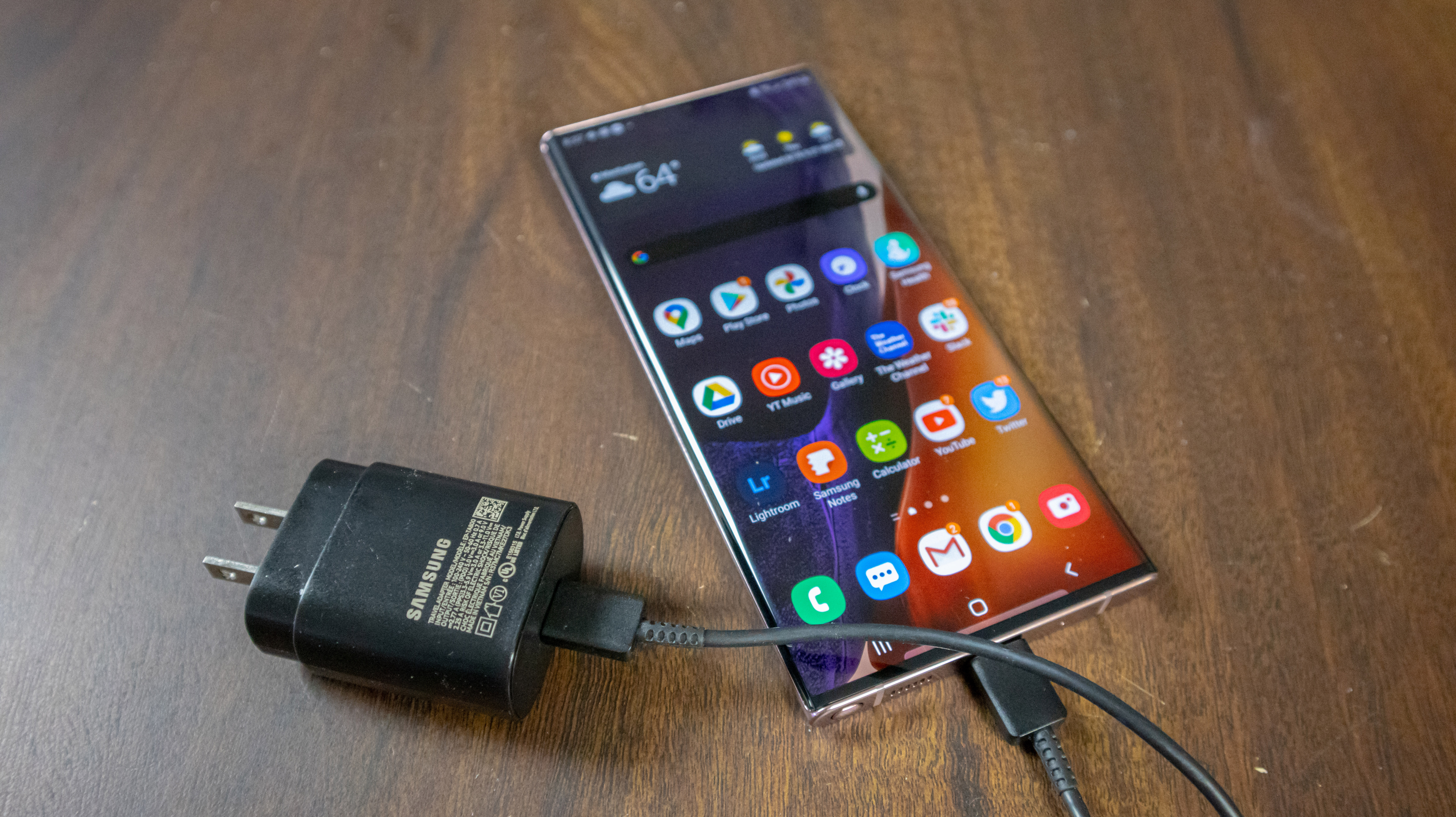
- For more in-depth camera nerdery, read our Canon EOS R5 review
Battery life
- All-day battery life despite the smaller 4,500mAh battery capacity
- We averaged 20% remaining after testing days, a good sign for power users
- 25W fast wired charging with included charger; not 45W-charger compatible
- 15W wireless charging returns
The Note 20 Ultra consistently lasted us a full day on a single charge with normal use. It’s not Samsung’s longest-lasting phone, and that comes down to the curbed battery capacity compared to the S20 Ultra – 4,500mAh for the Note 20 Ultra vs 5,000mAh for the S20 Ultra. That said, we found it to have enough juice for most power users who gravitate to a Note.
We often found that we had 20% left in the phone at the end of a day of testing, with such days often filled with taking photos and videos, and watching YouTube videos on the 6.9-inch screen. Battery life diminished faster on a 5G connection, but our testing has been limited to small pockets of the US and UK that have 5G – we’ll continue testing how this affects battery life as 5G expands.
In addition to solid all-day battery life Samsung has packed in fast 25W charging, fast 15W wireless charging and Wireless Power Share, so that you can top off someone else’s Qi-chargeable device, or perhaps your own earbuds. It’s also equipped with a comprehensive range of power-saving options when you’re the one in a pinch for power.
Oddly, what’s not on offer here is 45W wired charging, which is supported by last year’s Note 10 Plus, and this year’s S20, S20 Plus and S20 Ultra, via an adapter that Samsung sells separately. A few companies are even toying with 100W charging, but Samsung seems to be taking its time in rolling out truly fast charging.
The 25W charging in the box is appreciated – it took us just one hour and nine minutes to fully charge the Note 20 Ultra from empty – but the tech is out there that would allow Samsung to make that even faster.
Should I buy the Samsung Galaxy Note 20 Ultra?
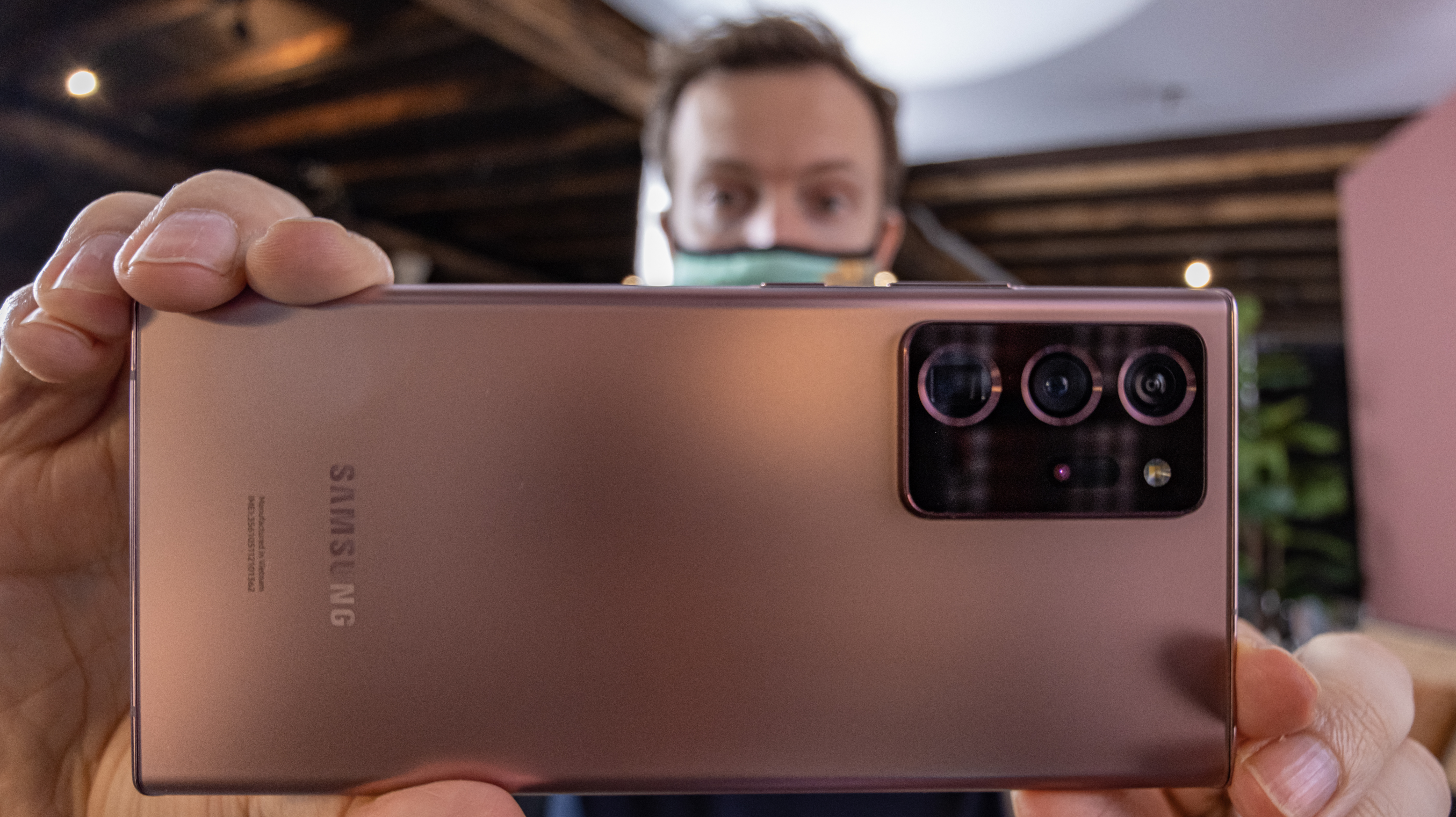
Buy it if...
You want an ‘everything phone’
The Note 20 Ultra has it all – almost: a big screen, superb camera, high refresh rate, the S Pen, in-screen fingerprint sensor, super-fast specs, 5G speeds, a fancy curved display. This phone is built for power users who want everything but the fastest charging speeds.
You want the best camera zoom
Distance no longer matters. The Note 20 Ultra camera, with its 5x optical zoom and 50x digital zoom, gets you really, really close to things. Photo quality diminished beyond 5x optical in low light and 10x zoom in good light, but what’s available here is way more useful than everyone else’s 2x zooms.
You’ll actually use the S Pen
The S Pen is more useful than ever, with features such as audio notes that sync with your scribbled-down notes – students and journalists will love it. The stylus also enables you to trigger remote selfies, and access other shortcuts, via gestures. It’s handy – if you’re going to use it.
Don't buy it if...
You want Samsung’s most cutting-edge phone
The Note 20 Ultra has plenty of wow factor to it, but it’s the Z Fold 2 that’s really going to turn heads, while the Galaxy S21 Ultra is a newer and arguably slightly better take on the conventional flagship.
You want value from a top-end phone
There are plenty of flagship smartphones that you can buy with great cameras, fast chip speeds, great screens, and 5G, and even some that do a 120Hz refresh rate and QHD resolution at the same time. But Samsung packs it all into one handset, with a stylus to boot.
You want to use a phone with one hand
Please get a Galaxy Note 20 Ultra case if you buy this phone and lead anything that resembles an active lifestyle (or are just clumsy with smartphones). This phone is big – and there are plenty of smaller options with many of the Note 20 Ultra’s features, including the S20, that you can operate with one hand.
Looking to save money on a Samsung product? Check out our Samsung coupon codes for the latest deals on top-rated tech and gadgets.
- Check out our hands-on Samsung Galaxy Note 20 review


